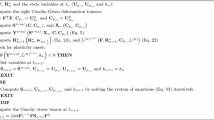Summary
Plastic yielding of anisotropic metals can be either described by a macroscopic constitutive relation or assessed by means of a model which correlates single and polycrystal behaviors. The mathematical identification of the plastic work rate derived from the two approaches, for all strain rate tensors, leads to a fit of the polycrystal yield surface by an analytical function. When a quadratic from is assumed, the macroscopic anisotropy parameters become explicit functions of the texture coefficients. This identification method is applied to calculate yield surfaces andR-values of rolled and annealed steel sheets: theR-values and in general the flow rule, are more significantly modified by the fitting than the yield surface. Thus, it is worth extending the method to more general constitutive relations which may be given by the form of their work function: alternative forms of the work function for plastic materials are explored, especially in the bearing of convexity and homogeneity where quadratic forms have a distinct advantage. Finally, it is shown that the identification of the work function allows to express the phenomenological coefficients as analytical functions of the texture parameters for many forms of the work function; in the other cases, these coefficients may be obtained by linear or non-linear regression.
Similar content being viewed by others
References
Taylor, G. I.: Plastic strain in metals. J. Inst. Metals62, 307–324 (1938).
Bishop, J. F. W., Hill, R.: A theory of the plastic distorision of a polycrystalline aggregate under combined stress. Phil. Mag.42, 414–427 (1951).
Hill, R.: A theory of the yielding and plastic flow of anisotropic metals. Proc. Roy. Soc.A 193, 281–297 (1948).
Hill, R.: Theoretical plasticity of textured aggregates. Math. Proc. Cambr. Phil. Soc.85, 179–191 (1979).
Montheillet, F., Gilormini, P., Jonas, J. J.: Relation between axial stresses and texture development during torsion testing: a simplified theory. Acta Metall.33, 705–717 (1985).
Lequeu, Ph., Gilormini, P., Montheillet, F., Bacroix, B., Jonas, J. J.: Yield surfaces for textured polycrystals. I. Crystallographic approach. Acta Metall.35, 439–451 (1987).
Lequeu, Ph., Gilormini, P., Montheillet, F., Bacroix, B., Jonas, J. J.: Yield surfaces for textured polycrystals. II. Analytical approach. Acta Metall.35, 1159–1174 (1987).
Arminjon, M.: Contribution à l'étude des relations entre les paramétres d'anisotropic et les fonctions de répartition des orientations cristallographiques des polycristaux métalliques. Thèse de Doctorat de 3ème cycle, Université de Grenoble, France (1981).
Arminjon, M.: Explicit relationships between texture coefficients and three-dimensional yield criteria of metals. In: Textures of materials (Brakman, C. M., et al., eds.), pp. 31–37. Zwijndrecht: Netherlands Soc. Mater. Sci. 1984.
Arminjon, M., Boehler, J. P.: Comportement plastique et texture cristallographique des métaux anisotropes. In: Comportement plastique des solides anisotropes (Boehler, J.P., ed.), pp. 133–155. Paris: Editions du CNRS 1985.
Arminjon, M.: Lois de comportement homogénéisées pour la plasticité des polycristaux. Mémoire d'Habilitation, Université Paris-Nord, France (1988).
Hill, R.: The essential structure of constitutive laws for metal composites and polycrystals. J. Mech. Phys. Solids15, 79–95 (1967).
Bunge, H. J.: Mathematische Methoden der Texturanalyse. Berlin: Akademie Verlag 1969.
Bunge, H. J.: Texture analysis in materials science. Mathematical methods. London: Butterworths 1982.
Bunge, H. J., Schulze, M., Grzesik, D.: Calculation of the yield locus of polycrystalline materials according to the Taylor theory. Peine-Salzgitter Berichte, Sonderheft (1980).
Gilormini, P., Bacroix, B., Jonas, J. J.: Theoretical analyses of 〈111〉 pencil glide in BCC crystals. Acta Metall.36, 231–256 (1988).
Canova, G. R., Kocks, U. F., Tome, C. N., Jonas, J. J.: The yield surface of textured polycrystals. J. Mech. Phys. Solids33, 371–397 (1985).
Barlat, F., Lian, J.: Plastic behavior and stretchability of sheet metals. Part I. A yield function for orthotropic sheets under plane stress conditions. Int. J. Plast.5, 51–66 (1989).
Barlat, F.: Crystallographic texture, anisotropic yield surfaces and forming limits of sheet metals. Mat. Sci. Eng.91, 55–72 (1987).
Barlat, F., Richmond, O.: Prediction of tricomponent plane stress yield surfaces and associated flow and failure behavior of strongly textured Fcc polycrystalline sheets. Mat. Sci.95, 15–29 (1987).
Arminjon, M.: Théorie d'une classe de modèles de Taylor “hétérogènes”. Application aux textures de déformation des aciers. Acta Metall.35, 615–630 (1987).
Stout, M. G., Hecker, S. S., Bourcier, R.: An evaluation of anisotropic effective stress-strain criteria for the biaxial yield and flow of 2024 Aluminum tubes. J. Eng. Mater. Techn.105, 242–249 (1983).
Vial, C., Hosford, W. F., Caddell, R. M.: Yield loci of anisotropic sheet metals. Int. J. Mech. Sci.25, 899–915 (1983).
Legait, J.: Prise en compte de l'anisotropie en vue du calcul par éléments finis de l'emboutissage. Mém. Et. Sci. Rev. Mét.86, 171–175 (1989).
Hill, R.: New horizons in the mechanics of solids. J. Mech. Phys. Solids5, 66–74 (1956).
Hill, R.: Extremal paths of plastic work and deformation. J. Mech. Phys. Solids34, 511–523 (1986).
Hill, R.: Constitutive dual potentials in classical plasticity. J. Mech. Phys. Solids35, 23–33 (1987).
Arminjon, M.: Texteres de déformation et écrouissage anisotrope de tôles d'acier. IRSID external report RE 1186, pp. 97–98 (1985).
Gotoh, M.: A theory of plastic anisotropy based on a yield function of fourth order (plane stress). Int. J. Mech. Sci.19, 505–520 (1977).
van Houtte, P., van Bael, A., Aernoudt, E., Pillinger, I., Hartley, P., Sturgess, C. E. N.: The introduction of anisotropic yield loci derived from texture measurements in elasto plastic finite elements calculations. In: Advances in plasticity 1989. Proc. 2nd Int. Symp. on Plasticity and its Current Applications. London: Pergamon Press 1989.
van Houtte, P., Mols, K., van Bael, A., Aernoudt, E.: Application of yield loci calculated from texture data. Textures and Microstructures11, 23–39 (1989).
Author information
Authors and Affiliations
Rights and permissions
About this article
Cite this article
Arminjon, M., Bacroix, B. On plastic potentials for anisotropic metals and their derivation from the texture function. Acta Mechanica 88, 219–243 (1991). https://doi.org/10.1007/BF01177098
Received:
Issue Date:
DOI: https://doi.org/10.1007/BF01177098




